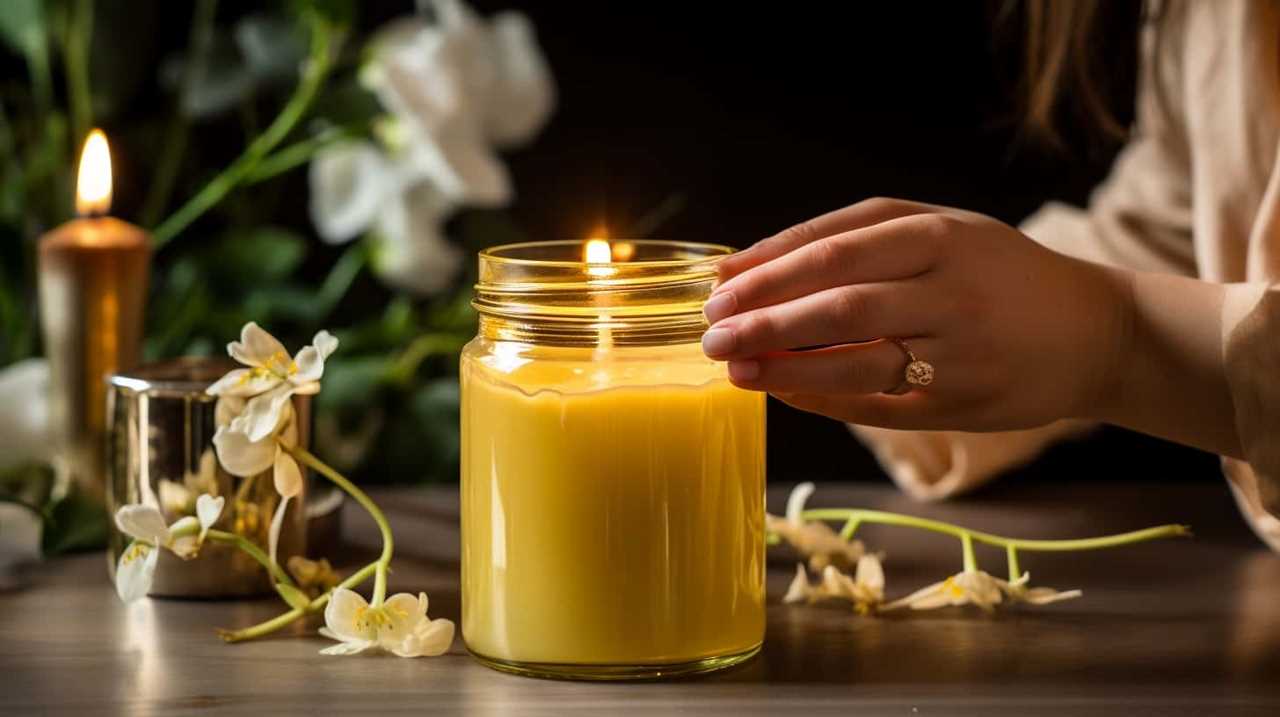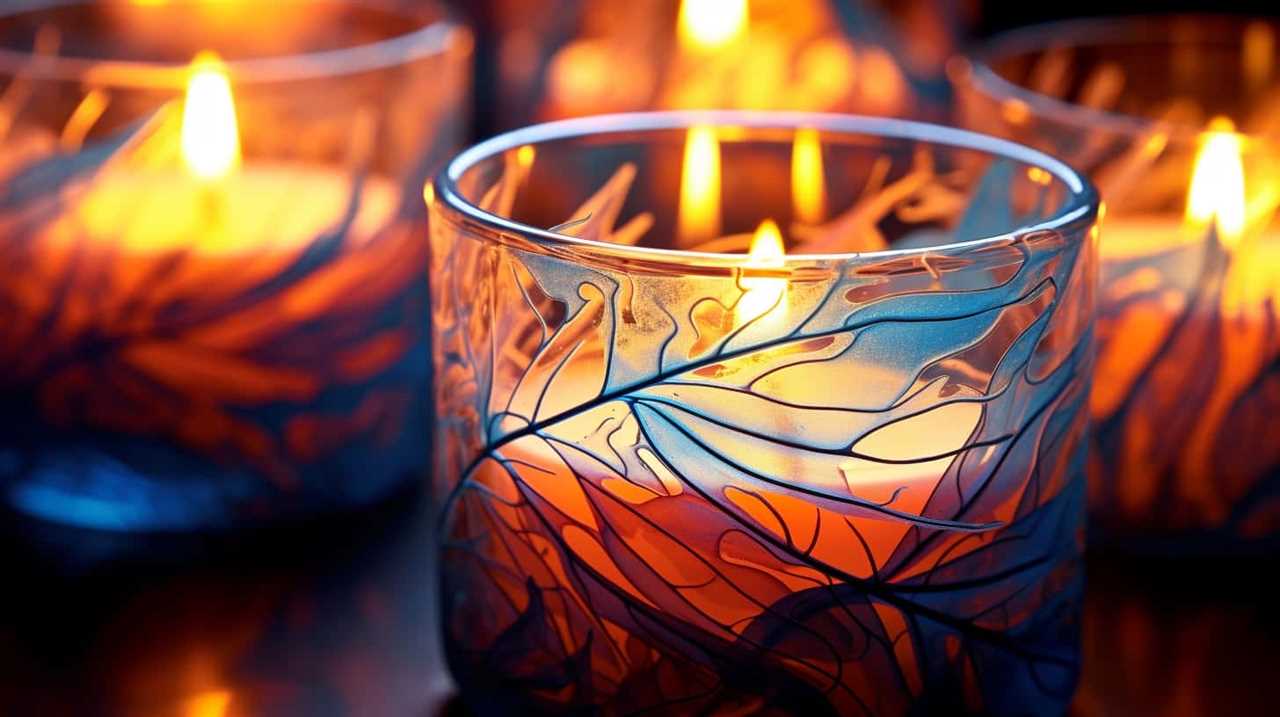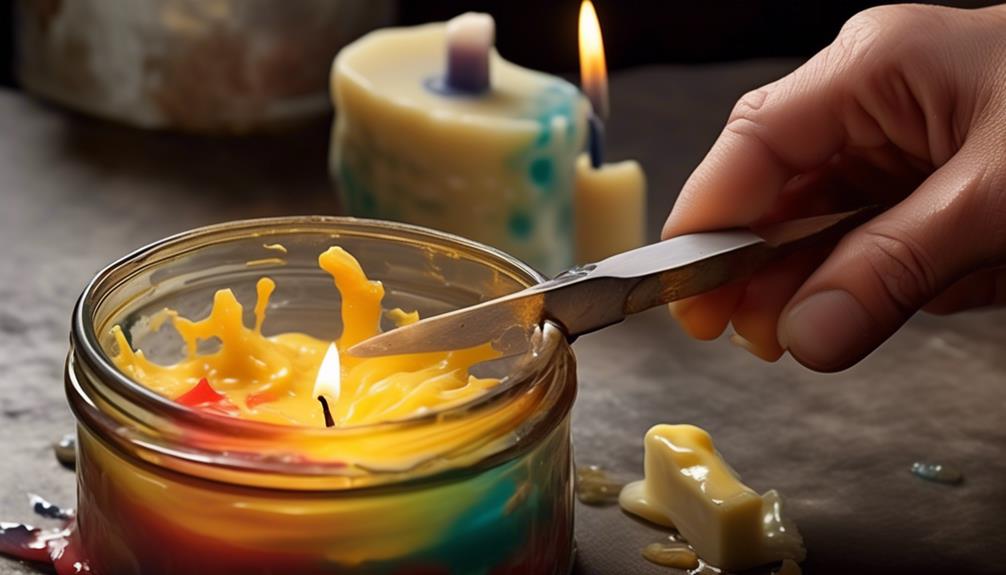You have designed beautiful concrete candle holders and are looking to further elevate their attractiveness. We have just the solution for you: a dependable method to seal your candle holders, guaranteeing they maintain a polished, sophisticated appearance.
In this guide, we will walk you through the step-by-step process of sealing your concrete candle holders, ensuring that they are protected against moisture and wear. From gathering the necessary materials to adding those final finishing touches, we’ll cover it all.
So grab your apron and let’s get started on transforming your concrete candle holders into stunning pieces that will be the envy of all who see them.
Let’s dive in, shall we?
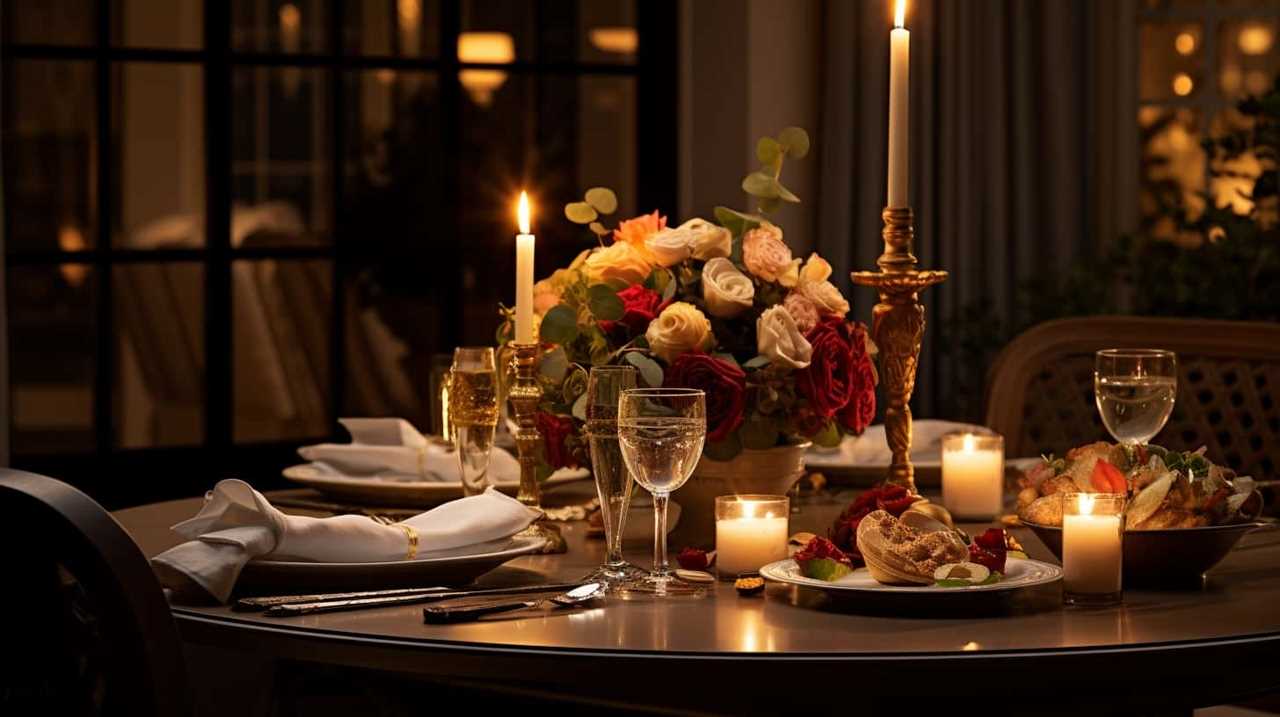
Key Takeaways
- Gathering necessary materials and preparing the work area are important steps before sealing concrete candle holders.
- Cleaning and sanding the surfaces of the candle holders ensures a smooth and even application of sealant.
- Applying a concrete sealant primer is necessary to enhance adhesion and durability.
- Patience is key during the drying time of the sealant, and multiple coats may be necessary for optimal protection.
Gather Necessary Materials
First, we gather the necessary materials for sealing concrete candle holders.
When it comes to sealant options, there are a few choices that offer different benefits. One option is a penetrating sealant, which is absorbed into the concrete to create a barrier against moisture and stains. Another option is a topical sealant, which sits on the surface and provides a protective layer. It’s important to choose a sealant that’s specifically designed for concrete to ensure optimal results.
In terms of sealing techniques, it’s crucial to thoroughly clean the candle holders and remove any dirt or debris before applying the sealant. Then, using a brush or roller, evenly apply the sealant in thin coats, allowing each coat to dry completely before applying the next. This will ensure a strong and durable seal for your concrete candle holders.
Prepare Your Work Area
To ensure a smooth and efficient process, we need to prepare our work area before sealing the concrete candle holders.
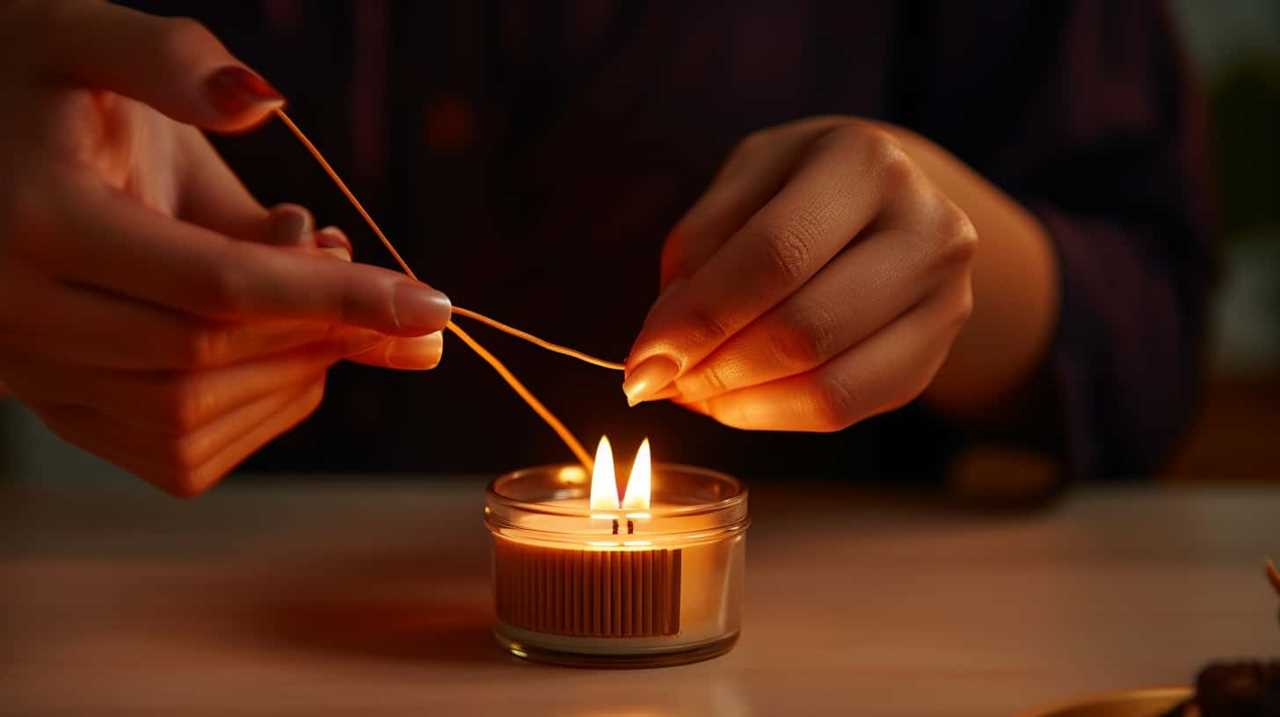
First, gather all the necessary cleaning tools such as a broom, dustpan, and wet cloth. Use the broom to sweep away any dirt or debris on the surface of your workspace.
Next, use the dustpan to collect the swept debris and dispose of it properly.
Afterward, dampen the wet cloth and wipe down the entire work area, removing any remaining dust or dirt.
Once the area is clean, organize your workspace by arranging the concrete candle holders in a neat and accessible manner. This will make it easier to apply the sealant evenly and efficiently.

Clean the Concrete Candle Holders
Let’s begin by gently scrubbing the concrete candle holders to remove any dirt or residue. Cleaning the candle holders properly is essential before sealing them to ensure a smooth and flawless finish.
Here are some effective cleaning techniques for removing stains from concrete candle holders:
- Use a mild detergent and warm water solution: Combine a small amount of mild detergent with warm water and apply it to the candle holders using a soft-bristled brush. Gently scrub the surface in circular motions to lift off any dirt or stains.
- Try vinegar and water mixture: Mix equal parts of white vinegar and water in a spray bottle. Spray the solution onto the candle holders and let it sit for a few minutes. Scrub the surface with a brush to remove any stubborn stains.
- Baking soda paste: Create a paste by mixing baking soda with water. Apply the paste to the stained areas of the candle holders and let it sit for about 15 minutes. Scrub the surface with a brush and rinse thoroughly.
- Use a pressure washer: If the candle holders have extensive stains or dirt buildup, consider using a pressure washer. Adjust the pressure to a suitable level and spray the holders to remove any debris or stains effectively.
Sand the Surfaces
After cleaning the concrete candle holders, we can now move on to sanding the surfaces for a smoother finish.
Sanding is an essential step in the process of sealing concrete candle holders as it helps to smooth out any rough surfaces and enhance durability.

To begin, gather a medium-grit sandpaper and a sanding block. Start by gently sanding the entire surface of the candle holder in a circular motion, applying even pressure. This will help to remove any imperfections or rough spots that may be present. Be sure to pay extra attention to any areas that feel particularly rough or uneven.
Once the surfaces have been sanded, wipe away any dust or debris with a clean cloth. Remember, a smooth and even surface will provide the best results when sealing the candle holders.
Apply a Concrete Sealant Primer
Now, we’ll move on to applying a concrete sealant primer in order to further protect and enhance the durability of the candle holders. This step is crucial in ensuring that your concrete candle holders are sealed and protected against moisture, stains, and other potential damage.
To achieve the best results, it’s important to follow proper sealant application techniques and ensure an even coating. Here are some key points to consider:

- Use a high-quality concrete sealant primer that’s specifically designed for indoor or outdoor use, depending on where you plan to place your candle holders.
- Prior to application, thoroughly clean and dry the surfaces of the candle holders to remove any dirt, dust, or residue.
- Apply the primer using a paintbrush or roller, making sure to cover the entire surface evenly and avoid any drips or puddles.
- Allow the primer to dry completely before proceeding with the next step.
Let the Primer Dry
Once the primer has been applied, we need to allow it to dry completely before moving on to the next step. Proper drying techniques are crucial to ensure a strong and durable seal on your concrete candle holders.
To expedite the drying process, it’s essential to provide adequate ventilation in the drying area. This can be achieved by opening windows or using fans to circulate the air. Additionally, maintaining a consistent temperature and humidity level can help speed up the drying time. It’s important to note that the drying time may vary depending on the type of primer used and the atmospheric conditions.
If you’re looking for alternative sealant options, you may consider using epoxy or acrylic sealants, which offer different levels of durability and protection.
Once the primer has completely dried, we can proceed to apply the first coat of sealant, ensuring a flawless finish.
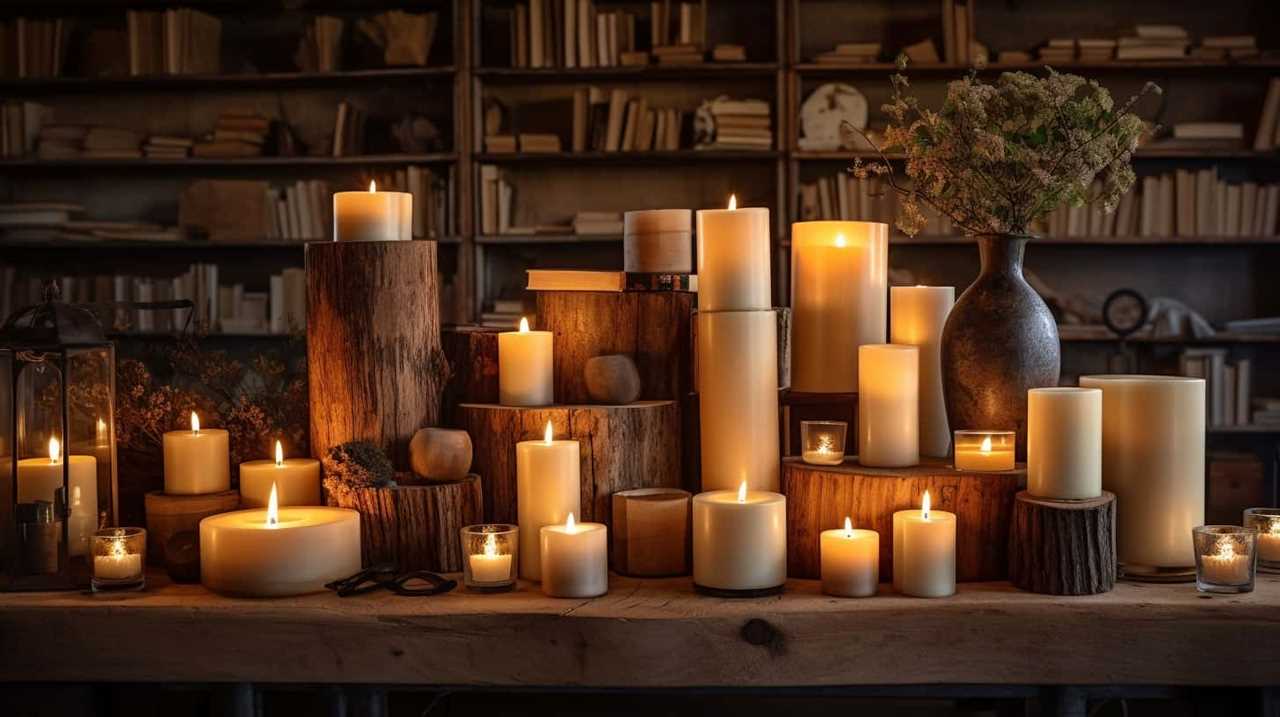
Apply the First Coat of Sealant
Now that the primer has dried, it’s time to apply the first coat of sealant to the concrete candle holders.
The drying time for the sealant will depend on the specific product being used, so be sure to follow the manufacturer’s instructions.
When applying the sealant, it’s important to use proper techniques such as brushing or spraying evenly to ensure a smooth and protective coating.
Drying Time for Sealant
We typically recommend allowing the first coat of sealant to dry for at least 24 hours before applying any additional coats. This drying time is crucial to ensure that the sealant fully sets and adheres to the concrete surface, providing optimal protection and longevity.
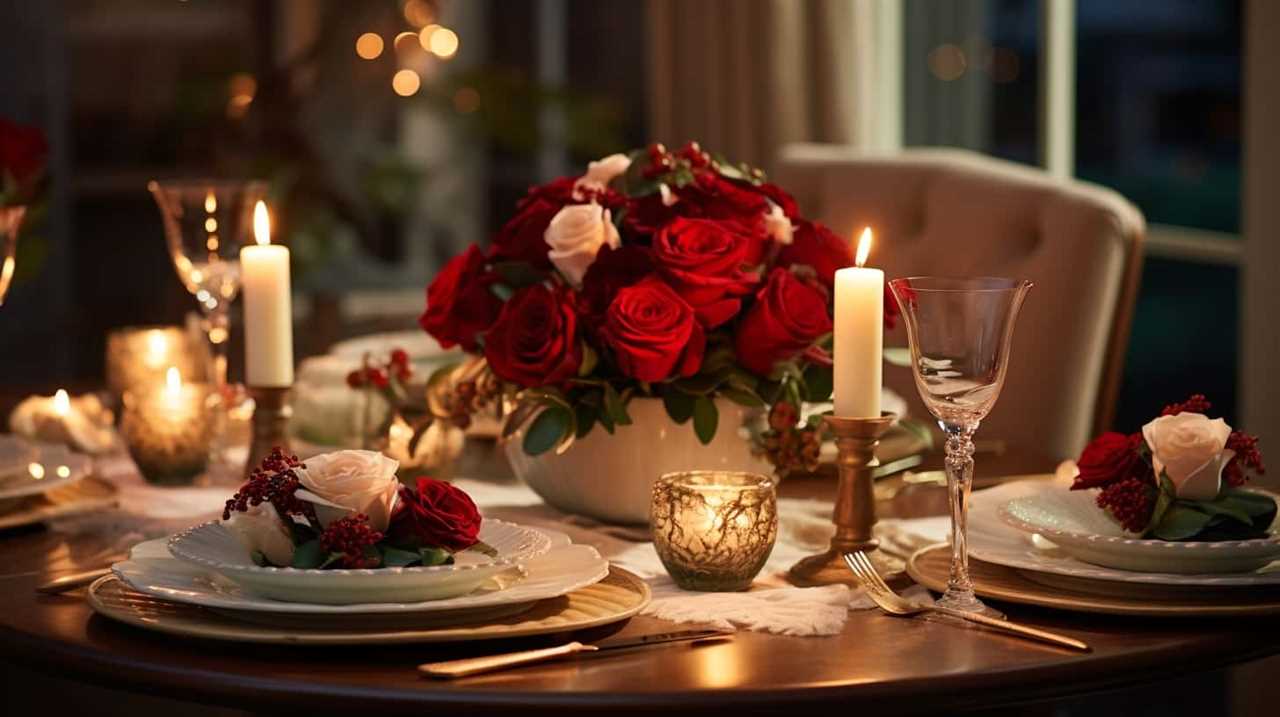
However, there are some drying techniques that can help speed up the drying process, such as using fans or dehumidifiers to increase air circulation and reduce moisture. Additionally, placing the candle holders in a warm and dry environment can also accelerate drying.
It’s important to note that rushing the drying process may compromise the effectiveness of the sealant, so patience is key. Once the first coat is fully dry, we can move on to the next step of sealant application techniques.
Sealant Application Techniques
To begin applying the first coat of sealant to the concrete candle holders, we will use a brush or roller. This ensures even coverage and allows for easy application. Before we proceed, it is crucial to choose the right sealant for the job. Consider factors such as the type of concrete, the desired level of protection, and the environment in which the candle holders will be placed. Here are some sealant application tips to keep in mind:
| Sealant Application Tips |
|---|
| Clean the surface thoroughly before applying the sealant |
| Use a brush or roller for a smooth and even application |
| Apply the sealant in thin, even coats to prevent drips and runs |
Importance of Even Coating
For the first coat of sealant application, it’s essential to ensure an even coating on the concrete candle holders. This step plays a crucial role in achieving the desired level of durability and long-lasting protection for your candle holders. Here are four reasons why an even coating is of utmost importance:
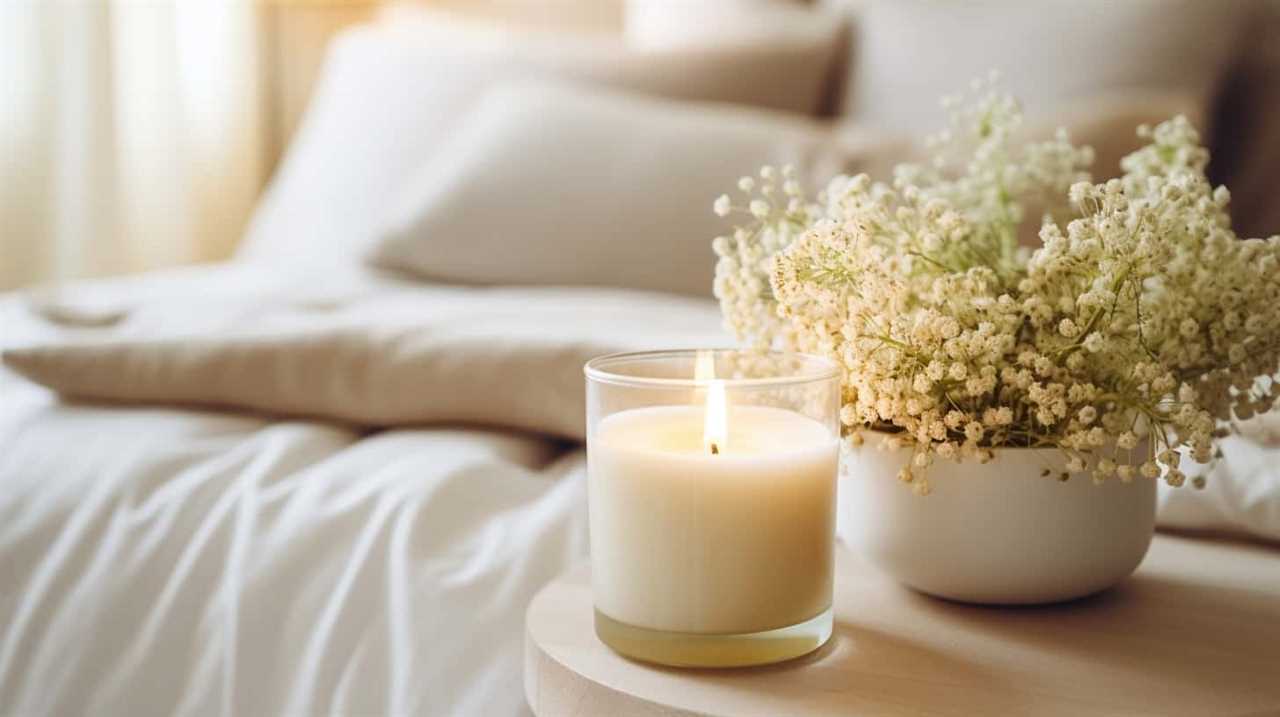
- Enhanced Durability: An even application of sealant creates a strong protective barrier that enhances the durability of the concrete candle holders, making them more resistant to wear and tear.
- Long-Lasting Protection: The even coating provides a consistent layer of protection against external factors such as moisture, heat, and UV rays, ensuring that your candle holders maintain their original condition for an extended period.
- Uniform Appearance: An even application ensures a uniform and aesthetically pleasing appearance, enhancing the overall visual appeal of the candle holders.
- Prevention of Cracks and Damage: Uneven coatings can lead to weak spots and cracks in the concrete, compromising the structural integrity of the candle holders. Applying an even coat helps prevent such issues, ensuring their longevity.
Allow the First Coat to Dry
Once the first coat of sealant has been applied to the concrete candle holders, it’s crucial to allow it to fully dry. The drying time for the coat will vary depending on factors such as temperature and humidity, so it’s important to exercise patience during this step. Rushing the process can result in a compromised seal and decreased durability.
Once the first coat is completely dry, we can move on to the next steps in sealing the concrete candle holders.
Drying Time for Coat
We recommend allowing sufficient drying time for the first coat of sealant to ensure a sturdy and long-lasting finish. Proper drying time is crucial as it allows the sealant to fully cure and adhere to the concrete surface.
Here are some tips for faster drying:
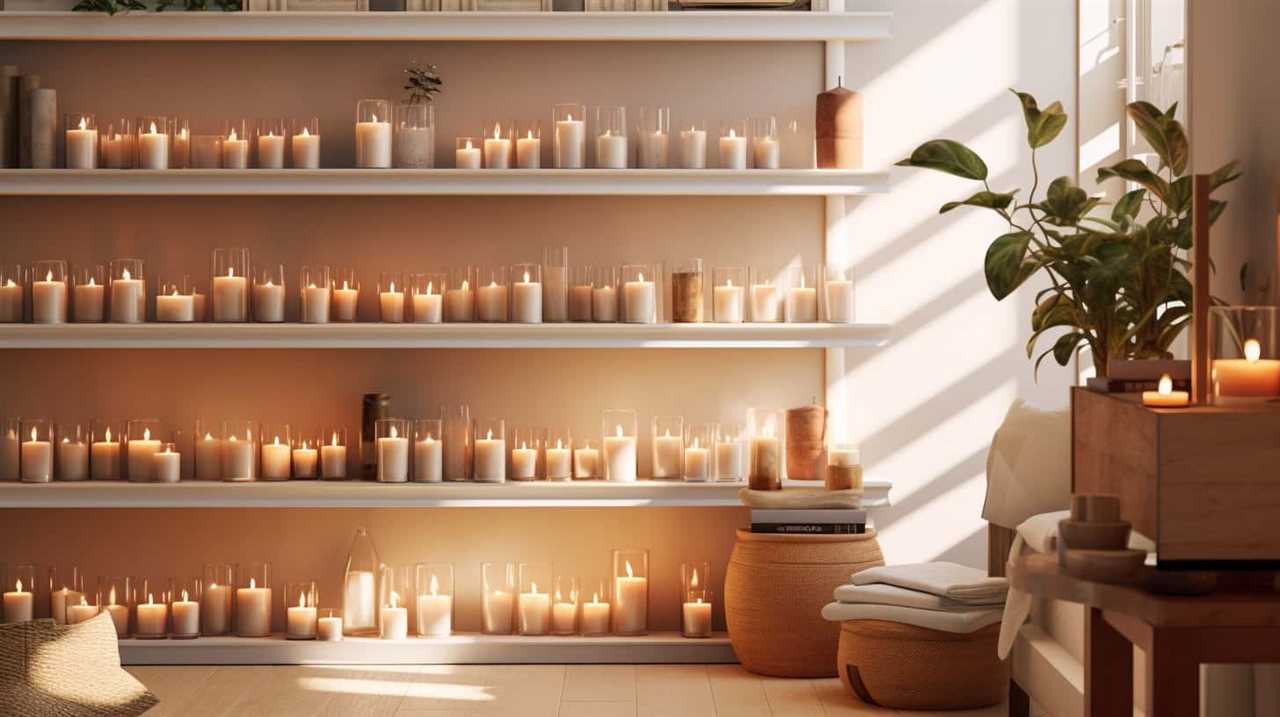
- Optimal temperature: Maintain a temperature between 70-80 degrees Fahrenheit for faster drying.
- Adequate ventilation: Ensure good air circulation in the drying area to expedite the evaporation process.
- Thin coat application: Apply a thin, even coat of sealant to promote quicker drying.
- Avoid high humidity: Sealants take longer to dry in high humidity, so try to seal your candle holders on a dry day.
Importance of Patience
Typically, we recommend patiently allowing the first coat of sealant to fully dry before proceeding with the next steps. This step is crucial in the process of sealing concrete candle holders as it ensures the best results and longevity of the seal. The importance of perseverance and the benefits of practicing patience can’t be overstated in this regard.
By allowing the first coat to dry completely, you allow the sealant to bond effectively with the concrete surface, creating a strong and durable barrier against moisture, stains, and other damage. Rushing this step may result in a compromised seal and a shorter lifespan for your candle holders.
Practicing patience also allows you to observe the drying process and make any necessary adjustments before proceeding. It gives you the opportunity to ensure that the first coat is evenly applied and free from any imperfections. This attention to detail ultimately leads to a more professional and aesthetically pleasing finish.
Once the first coat is fully dry, you can confidently move on to the next steps in the sealing process, which will be discussed in the following section.
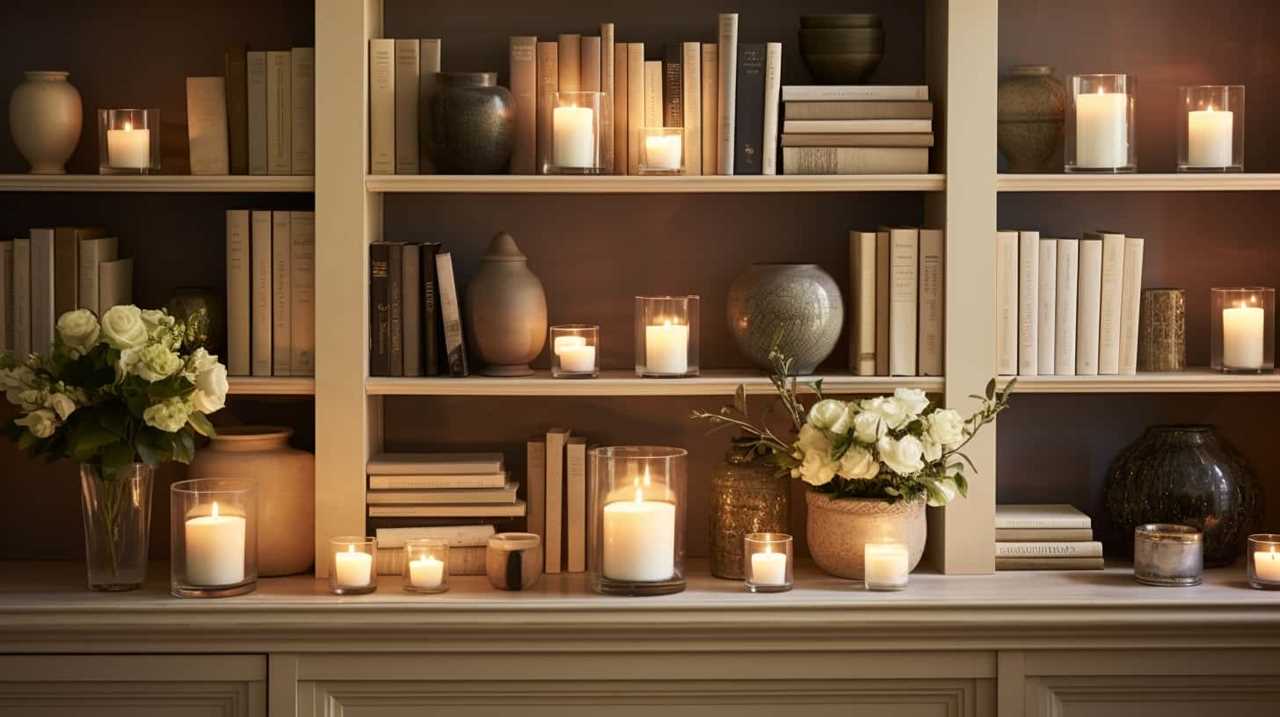
Next Steps After Drying
After allowing the first coat of sealant to fully dry, we can proceed with the next steps in sealing the concrete candle holders.
Repairing cracks and enhancing durability are crucial aspects of this process. Here are the next steps to follow:
- Inspect the sealed surface for any visible cracks or imperfections.
- Use a concrete repair compound to fill in any cracks or gaps. Ensure that the compound is compatible with the sealant used.
- Smooth out the repaired areas with a putty knife or trowel, ensuring a seamless finish.
- Allow the repair compound to dry completely before moving on to the next step.
By addressing cracks and imperfections, we ensure that the sealant adheres properly and provides maximum protection. This enhances the durability of the concrete candle holders, allowing them to withstand the test of time.
Following these steps diligently will result in a professionally sealed and long-lasting finished product.
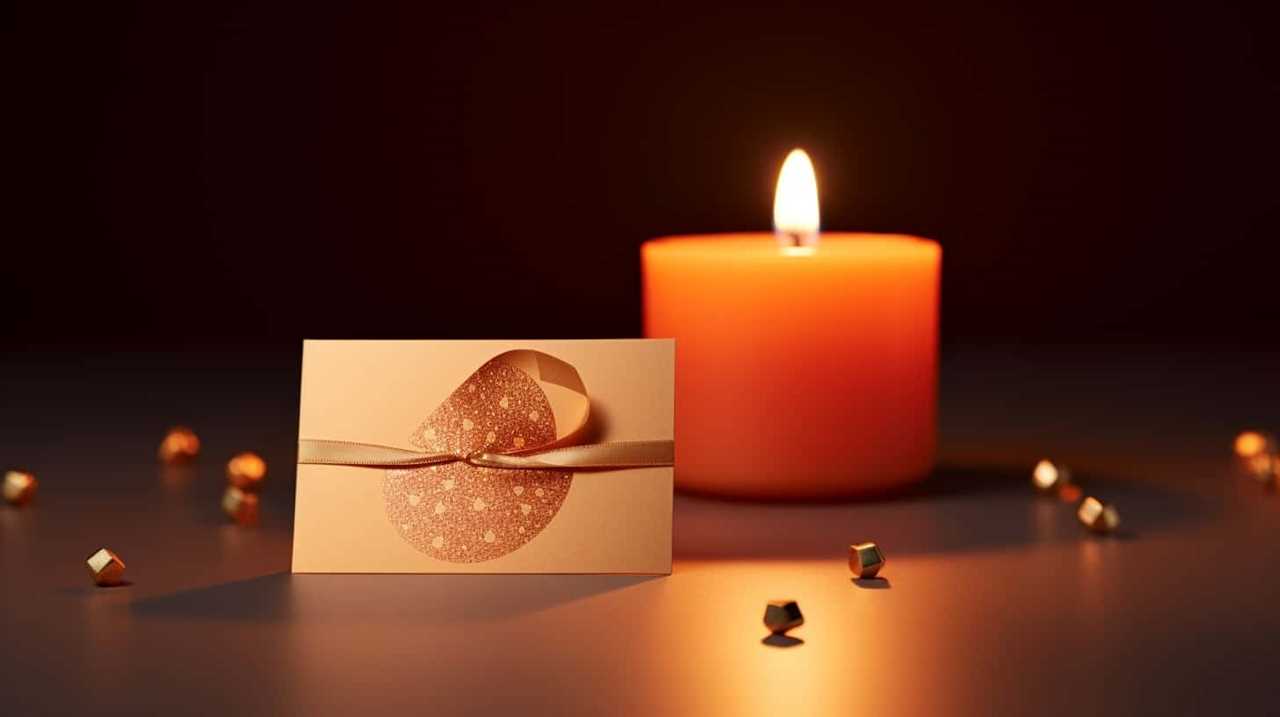
Apply Additional Coats if Desired
Applying additional coats of sealant enhances the durability and longevity of the concrete candle holders. To achieve the desired finish, it is recommended to apply multiple coats of sealant. Each coat adds an extra layer of protection, fortifying the surface against moisture, stains, and wear. Here is a table outlining the steps to follow when applying additional coats:
| Step | Description |
|---|---|
| 1 | Ensure the previous coat is completely dry. |
| 2 | Lightly sand the surface to remove any imperfections. |
| 3 | Apply the next coat of sealant using a brush or roller. |
| 4 | Allow the coat to dry according to the manufacturer’s instructions. |
Let the Final Coat Dry Completely
Once we’ve applied the final coat of sealant to the concrete candle holders, we need to allow it to dry completely. Proper drying techniques are crucial in maintaining the durability of the sealant and ensuring long-lasting protection for your candle holders.
Here are some key points to consider during the drying process:
- Avoid direct sunlight: Direct sunlight can cause uneven drying and may lead to cracking or discoloration of the sealant.
- Provide adequate ventilation: Good airflow will help expedite the drying process and prevent moisture buildup, which can compromise the effectiveness of the sealant.
- Maintain optimal temperature: Ideally, the temperature should be between 50°F and 90°F, as extreme temperatures can impede drying and affect the overall quality of the sealant.
- Allow sufficient time: Patience is essential. Depending on the weather conditions and the type of sealant used, it may take anywhere from 24 to 72 hours for the final coat to dry completely.
Once the sealant is fully dried, we can proceed to inspect and touch up any imperfections that may have arisen during the drying process.

Inspect and Touch up Any Imperfections
Now that the final coat of sealant has dried completely, it’s time to carefully inspect the concrete candle holders for any imperfections. We’ll focus on three main points:
- Repairing any cracks that may have formed during the drying process.
- Smoothing out any rough surfaces that could affect the overall finish.
- Enhancing the appearance of the candle holders.
Repairing Concrete Cracks
To ensure a smooth and polished finish, we thoroughly inspect the concrete candle holders for any cracks or imperfections before proceeding with the repair process. It’s crucial to address any concrete cracks promptly to prevent further damage and maintain the structural integrity of the candle holders.
Here are some key steps we follow when repairing concrete cracks:
- Assess the extent of the damage: We carefully examine the cracks to determine their size, depth, and potential causes.
- Prepare the crack for repair: We clean the crack thoroughly, removing any loose debris or dirt that may interfere with the repair.
- Fill the crack: Using a high-quality concrete crack filler, we carefully fill the crack, ensuring that it’s completely filled and level with the surrounding surface.
- Smooth the repaired area: After the filler has dried, we smooth out the area to create a seamless finish.
Smooth Out Rough Surfaces
We inspect the concrete candle holders for any rough surfaces or imperfections that may require touch-ups. Before sealing the candle holders, it’s crucial to ensure that the surfaces are smooth and free from any cracks or blemishes. To achieve a flawless finish, we must address any rough areas or imperfections that we come across during the inspection process.
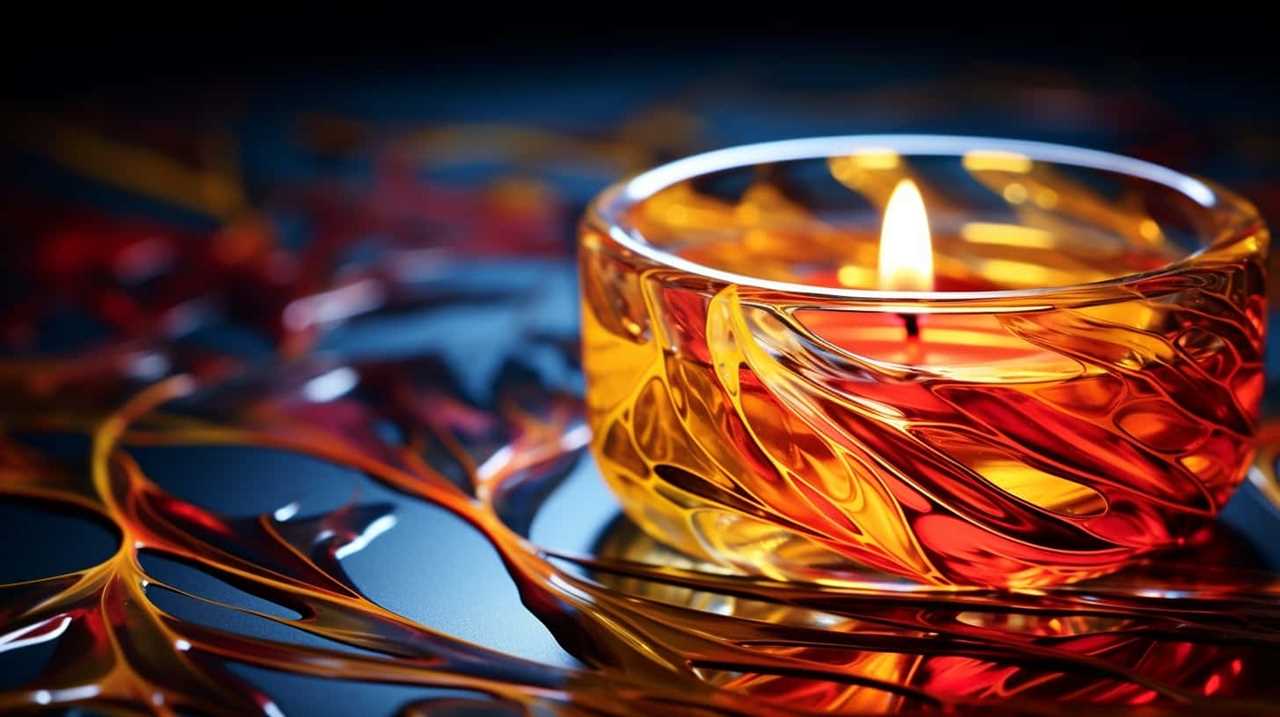
To begin, we carefully examine the candle holders, paying close attention to the surface texture. Any cracks or uneven areas should be repaired before proceeding with the sealing process. We use a high-quality concrete repair product to fill in the cracks and smooth out the rough surfaces. It’s important to follow the manufacturer’s instructions for proper application and drying time.
Once the repair work is complete, we move on to surface preparation. This involves thoroughly cleaning the candle holders to remove any dirt, dust, or debris. We use a mild detergent and water solution, along with a scrub brush, to ensure that the surfaces are clean and ready for sealing.
Enhance Overall Finish
After addressing any rough surfaces or imperfections, we proceed to enhance the overall finish of the concrete candle holders by inspecting and touching up any remaining blemishes. This step is crucial in achieving a flawless and professional-looking final product.
Here are four key aspects we focus on to improve durability and prevent staining:

- Smoothness: We carefully examine the surface of each candle holder, feeling for any areas that may require further attention. By ensuring a smooth finish, we create a visually appealing product that will withstand the test of time.
- Color consistency: We meticulously inspect the color of the concrete and compare it to our desired outcome. Any discrepancies in color are addressed, and touch-ups are made to achieve a consistent and uniform appearance.
- Seamlessness: We pay close attention to the seams and joints of the candle holders, ensuring they’re seamless and free from any visible imperfections. This meticulous attention to detail enhances the overall aesthetic and quality of the finished product.
- Cleanliness: Before proceeding, we thoroughly clean the candle holders, removing any dust, debris, or fingerprints. This not only improves the appearance but also ensures a smooth and flawless application of the sealer.
Add Finishing Touches
Once the sealing process is complete, the final step is to enhance the appearance of the concrete candle holders with a touch of elegance. Adding finishing touches not only improves the overall aesthetics but also helps to protect the concrete from potential damage. To achieve this, there are several options to consider:
| Finishing Touches | Description |
|---|---|
| Paint | Apply a coat of paint to add color and style to the candle holders. Choose a paint that is specifically designed for concrete surfaces to ensure durability. |
| Metallic Accents | Add a touch of sophistication by incorporating metallic accents such as gold leaf or metallic paint. These accents can be applied to specific areas or used to create patterns or designs. |
| Decorative Elements | Enhance the visual appeal by attaching decorative elements such as beads, shells, or mosaic tiles. These elements can be embedded into the concrete or glued onto the surface. |
| Sealing | Apply a final layer of sealant to protect the finishing touches and provide additional durability. Choose a sealant that is compatible with the paint or decorative elements used. |
Display and Enjoy Your Sealed Concrete Candle Holders
To showcase our sealed concrete candle holders, we can proudly display and enjoy them in various areas of our home. With the right display techniques and candle holder placement, we can create a captivating ambiance that enhances the overall aesthetic of our living space.
Here are four markdown bullet points to inspire our audience:
- Create a centerpiece: Place the sealed concrete candle holders on a dining table or coffee table to serve as a stunning centerpiece that draws attention and sparks conversation.
- Utilize shelving: Arrange the candle holders on a wall-mounted shelf to add visual interest and create a focal point in any room.
- Accentuate corners: Position the candle holders in the corners of a room to create a cozy atmosphere and make the space feel more intimate.
- Outdoor elegance: Bring the sealed concrete candle holders outdoors and place them on a patio or deck to create a warm and inviting atmosphere for gatherings or relaxation.
Frequently Asked Questions
How Long Should I Let the Primer Dry Before Applying the First Coat of Sealant?
We recommend letting the primer dry for at least 24 hours before applying the first coat of sealant. The drying time may vary depending on the specific primer used. As for the sealant, the best type to use would be a waterproof concrete sealant for optimal protection.
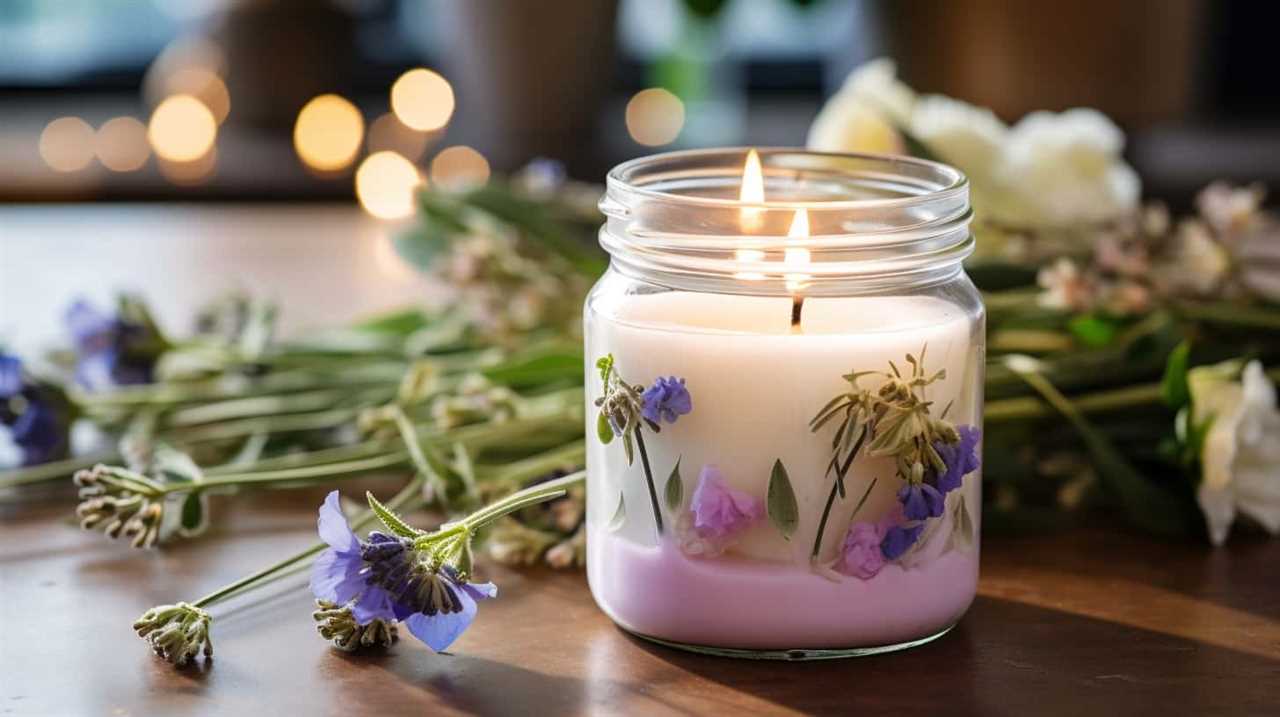
Can I Use Any Type of Sealant on My Concrete Candle Holders?
Yes, you can use different types of sealants on your concrete candle holders. However, it’s important to choose the best sealant for concrete. Consider factors like durability, water resistance, and heat resistance when making your selection.
Do I Need to Sand the Surfaces of My Candle Holders Before Applying the Sealant?
Before applying the sealant, sanding the surfaces of the candle holders is necessary to ensure proper adhesion. It creates a rough texture for the sealant to grip onto. However, there may be alternative sealants that do not require sanding.
How Many Coats of Sealant Should I Apply for Optimal Protection?
For optimal protection, we recommend applying two coats of sealant to your concrete candle holders. The first coat will provide a base layer, while the second coat will enhance durability. Make sure to choose the right sealant and apply it evenly for best results.
Can I Use My Sealed Concrete Candle Holders Outdoors?
Yes, you can use sealed concrete candle holders outdoors. Applying multiple coats of sealant using proper sealing techniques and using the best outdoor sealants will provide optimal protection against weather elements and ensure longevity.
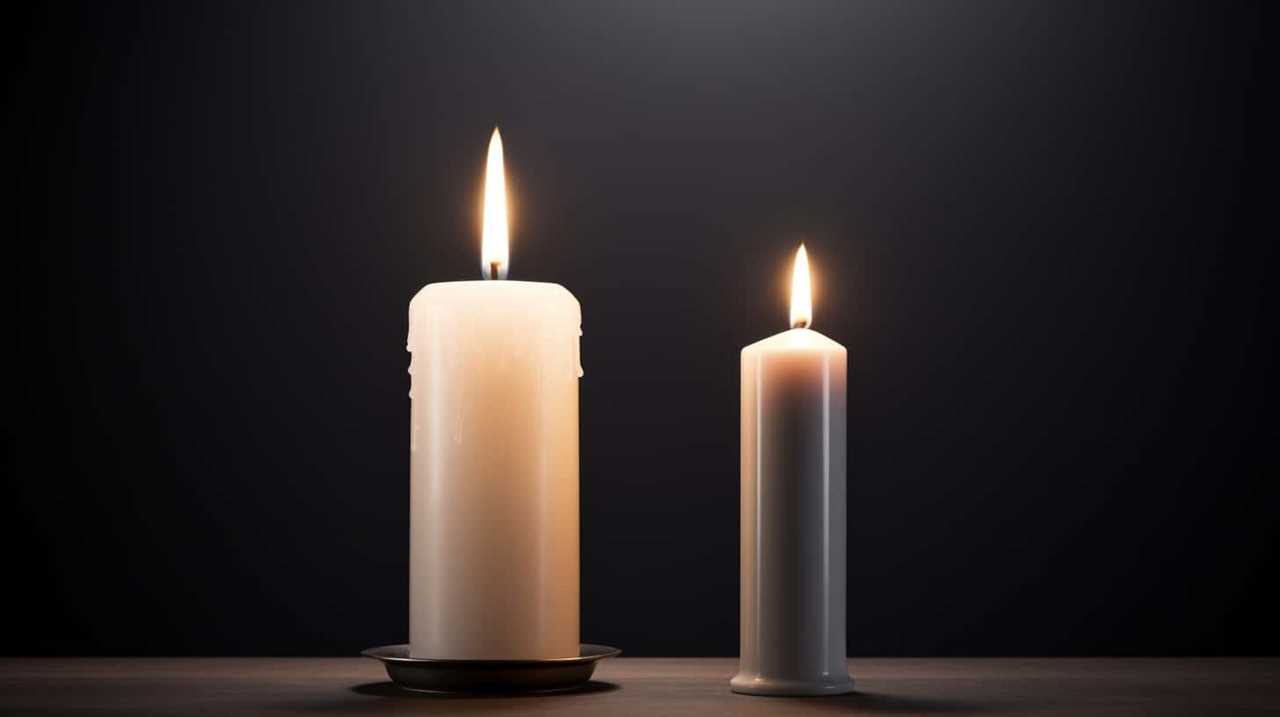
Conclusion
After following these meticulous steps to seal your concrete candle holders, you can finally enjoy the irony of their delicate appearance contrasted with their robust protection.
The precise application of the sealant ensures that your candle holders will withstand the test of time, providing a beautiful addition to your home decor.
So, sit back, relax, and revel in the irony of concrete elegance.
